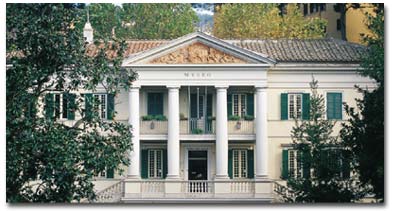This impressive neoclassic building is immersed in a park surrounded by centuries-old pine trees and wonderful magnolia plants. It is located in the south east of the town centre and has been the premises of the Musei Civici di Albano Laziale since 1983. The Museum, founded in 1975 has 23 rooms arranged over three floors with an adjoining library of science, history and archeology. The central part of the building was planned by the architect Francesco Gasparoni in 1834 and intended as an elegant casino; later, after the purchase by the Marchese Giuseppe Ferrajoli, two side buildings were added. The left side building was used as horse stables and the right side building for agricultural use. In 1948 the building became part of the town’s property. The central avant-corps in the shape of a tetrastyle pronao, in perfect neoclassic style, is decorated with a terracotta high relief carving by Rinaldo Rinaldi, illustrating the myth of “Ceres who offers Triptolemus a sheaf of wheat while she is teaching him to plough the land”. To enter the building there are two symmetrical staircases on both sides of the main entrance.

The decorations, paintings and grotesque motifs in the interior rooms are all works of the artist Giovanni Battista Caretti and are based on neoclassical-renaissance style depicting mythological subjects and landscape representations. The decorations of only ten vaults have been conserved, including that of the pronao. In each one, there are four trapezoidal shaped frames representing dogs interlaced in a leaf like raceme motif. We would like to point out the beauty of the vault at the top of the stairway with its greyish and blueish star-shaped wheel; the fine range of colours of the Conference Hall; the details of the licentious putti inside the flower wreath on the ceiling in the museum’s management office, the ornamental decorations of acanthus foliage and the small rosette designs of the original floor; the optical illusion of the faux caisson, in octagon, squared and rectangular shapes seem to reproduce the blue sky on the ceiling above the staircase leading to the second floor.
In the Sala XI, on the second floor, it is worth noting certain features such as the original “cotto” tiled floor, the oval inside the central rectangle containing two gracious putti as well as the wreath of flowers and leaves spaced out by small circles decorated with butterflies and diamond shapes illustrating trophies which resemble motifs of some of the vaults of the Domus Aurea.
The archeological findings on display go from the Paleolithic to the Medieval periods; those of great importance are the remains dating back to the Stone Age and those of the fauna of the Paleolithic Age (300,000 – 30.000 years ago) such as the tusks of the Palaeoloxodon Antiquus (straight-tusked elephant).
An excellent representation of the archaic period is the small polychrome head of a Latin warrior of the 5th century BC of great value, together with a high-relief from a temple, showing a scene of Maenads and Satyrs dancing.
Inside other rooms we can see findings from ancient villas such as Pompey’s imperial villa, the Roman villa of Cavallacci (marble head of Tiberius Gemellus) and the one near Cancelliera (head of Faustina Maggiore).
The Museum also has a considerable collection of drawings, which boasts several works by Giovan Battista Piranesi and other great artists dating from the 1600s to the 1900s. The Museum also offers some very interesting educational services, with interactive touch screen video facilities, guided tours, hardcopy guides in English and Italian, educational videos, a classroom for practice exercises, scientific and educational publications, postcards, reproduction of ancient prints and illustrative brochures.
The Musei Civici di Albano Laziale is part of a museum network, which includes the Museo della Seconda Legione Partica, i Cisternoni, l’Anfiteatro, le Catacombe di S. Senatore, la Chiesa di S. Maria della Rotanda.
For information on entrance fees and opening times please contact directly the museum.


 Visit Castelli Romani
Visit Castelli Romani 

